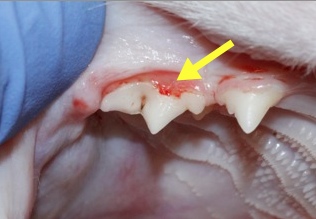News
Pet of the Month – June 2013
by on May 31st, 2013
Category: Pet of the Month, Tags:
 Dudley has been a real star. When he was first brought in to our clinic he was dribbling and having difficulty in eating. It soon became apparent that he was suffering from Feline Odontoplastic Resorptive Lesions often shortened to ‘Tooth Resorption’. He has made a swift recovery from the trauma of the multiple tooth extractions which were necessary to relieve his pain. This condition represents one of the most common diseases seen in domestic cats and occurs in 20-75% of cats depending on the population studied.
Dudley has been a real star. When he was first brought in to our clinic he was dribbling and having difficulty in eating. It soon became apparent that he was suffering from Feline Odontoplastic Resorptive Lesions often shortened to ‘Tooth Resorption’. He has made a swift recovery from the trauma of the multiple tooth extractions which were necessary to relieve his pain. This condition represents one of the most common diseases seen in domestic cats and occurs in 20-75% of cats depending on the population studied.
Older and purebred cats are more likely to be affected and the numbers of teeth that can be affected increases with age. This unusual condition was probably first identified properly in the 1920’s although the problem has now been demonstrated in the teeth of cats dating back to the 13th and 14th centuries!! Also the domestic cat’s larger relatives haven’t escaped this one as similar lesions have been identified in wild cats including Lions and Tigers.
Despite this being a common condition, the cause of tooth resorption is still not known. Recent studies have suggested that Vitamin D metabolism may be important but as yet there is no known way of preventing the condition from developing.
What Are The Signs of Tooth Resorption in Cats?
Initially cats with affected teeth may not show any symptoms at all. However once a significant amount of erosion of the tooth develops and is visible, the condition will usually then result in pain. As the disease progresses the symptoms your cat may show include difficulty in eating, dribbling saliva, face rubbing, jaw chattering and weight loss.
How is Tooth Resorption Diagnosed?
Tooth resorption is usually diagnosed by your vet during a dental check up often as part of the full clinical examination that will be carried out before a booster vaccination or if your cat is not well. They can also be detected if your vet has the opportunity to examine your cat’s teeth under a general anaesthetic. Not all cases of tooth resorption are obvious. Sometimes they can be hidden beneath the gum line and dental x-rays are required to detect them. See picture enclosed.
How is Tooth Resorption Treated?
The treatment for all teeth with tooth resorption is extraction as they are likely to cause pain as the disease progresses and there is no medical treatment to cure this problem. The extraction of teeth in cats is usually a surgical procedure. The teeth can be fragile and tricky to remove. Fortunately, most patients recover rapidly after tooth extraction and will often be much happier once these painful teeth have been extracted.
You can leave a response, or trackback from your own site.

